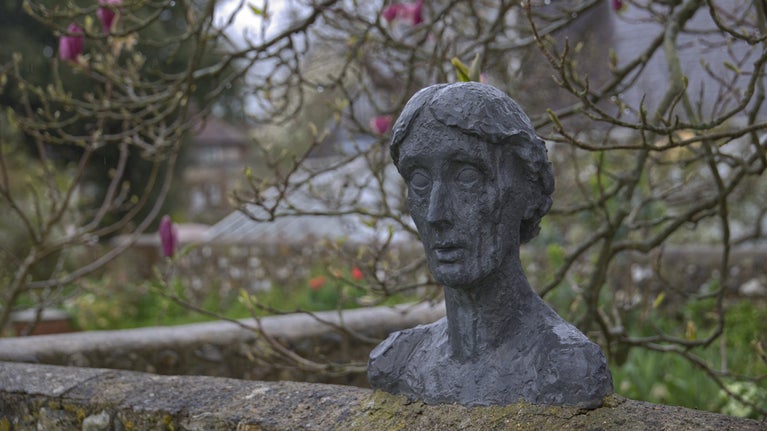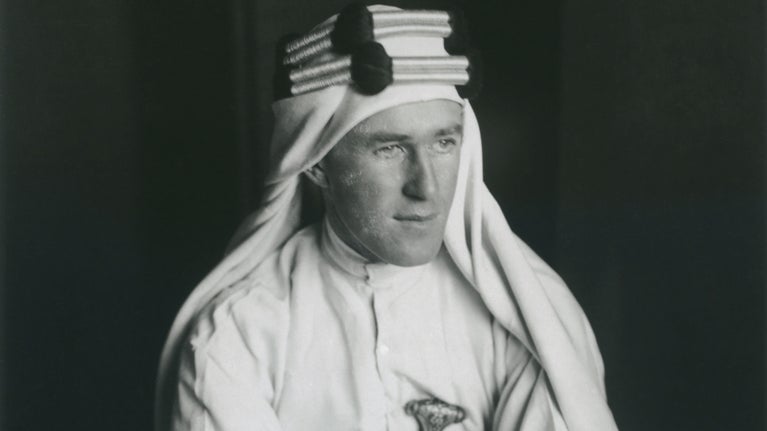
People in history
Discover some of the social history behind the places we care for and uncover fascinating facts about the people who have lived in them.

LGBTQ+ people and their stories are an important part of the history of the nation. Learn about some of the places we care for that have been shaped by or were home to people who's gender and sexuality was outside the wider society's conventional ideas of the time.
LGBTQ+ is an acronym for Lesbian, Gay, Bisexual, Transgender, Queer/Questioning and other sexual identities. It's widely accepted as an inclusive term to reference the diversity of gender and sexuality that go beyond the ‘hetero-normative’ conventions (binary definitions of gender and of ‘one man with one woman’ relationships).
‘Queer’ used to be seen as a term of abuse but has now been largely reclaimed by the LGBTQ+ community. It's also begun to be used as a term that encompasses all aspects of difference across gender and sexuality and look at gender and sexuality as a spectrum rather than a series of definite, fixed categories.
The author Virginia Woolf was a leading light of the Bloomsbury movement in the early 20th century. Her life was shaped by her unconventional approach to gender and sexuality. She was married to Leonard Woolf for 30 years but had several affairs with women including Vita Sackville-West.
In 1919, Virginia and Leonard purchased Monk's House, East Sussex and used it as their writers retreat.
Vita Sackville-West and Harold Nicolson, who bought and renovated Sissinghurst Castle Garden in Kent, enjoyed an open marriage and both had numerous same-gender extramarital relationships.
Vita, a poet, author and journalist in her own right, had an affair with Virginia Woolf and was the inspiration for Woolf's novel, Orlando in which the eponymous protagonist lives for centuries and changes gender. Virginia gave the original manuscript of the novel to Vita and it's now part of the collections at Knole, Kent – Vita's ancestral home.

Edward (Eddy) Sackville-West, was Vita Sackville-West's cousin and the reluctant heir of Knole in Kent. He was a writer and music critic. The decorated interiors of Eddy's apartments in the Gatehouse Tower, where he lived between 1926 and 1940, were a celebration of his identity. He was a gay man and had many passionate but fleeting affairs there.
In 1945, Eddy moved to Dorset and built a home with like-minded friends where they were free to express their creativity and sexuality.
Oliver Messel was one of the most important stage designers of the 20th century. He grew up at his family home of Nymans in West Sussex, surrounded by art and culture. For 24 years, Oliver was in a same-gender relationship with Vagn Riis-Hansen, who supported him through some of his happiest and most creative years.
Oliver and Vagn's ashes are together at Nymans but until recently it was only Oliver's name and dates that appeared on the memorial. In 2024, Vagn's were finally added.

Known as 'the dancing Marquess,' Henry Cyril Paget, 5th Marquess of Anglesey, was considered the 'black sheep' of the family owing to his eccentric behaviour and love of performance and costume. He modernised the stage in Plas Newydd's chapel by creating an auditorium with 150 seats and introducing electricity. He himself would perform dance shows there.
However, his lavish lifestyle caused financial issues and in 1904, he sold off practically everything including clothes and the housekeepers parrot to try and pay off his debts.
The famous murals painted by Rex Whistler can be seen in several country houses in our care, including Plas Newydd in Wales and Mottisfont in Hampshire. He was at the centre of a prominent group of artists, many of whom were queer. Most of his friends and contemporaries assumed Whistler was a gay man himself, and he had romantic involvements with both men and women.
Edith Craig was a prominent producer, writer and actor. Along with her partners Christopher St John and Tony Atwood, the three women found refuge in Smallhythe Place in Kent to express their art, gender and sexuality, living together as a trio.
Edith and Christopher were campaigners in the suffragette movement. In 1909, A Pageant of Great Women was performed. It was a spectacle that showcased historical heroines including Sappho, Jane Austen, Elizabeth Fry, and Joan of Arc that Edith wrote with the dramatist and actor, Cicely Hamilton. Christopher was arrested twice that same year for obstucting police and setting fire to a postbox.
After Edith's death in March 1947, Christopher recalled: ‘Different as were our antecedents, our characters, our temperaments, our talents, we belonged to the same world, the artist's world. That established a camaraderie which was perfectly easy, unguarded and spontaneous.'

Oscar Wilde was a poet and playwright who inspired the interiors of Wightwick Manor in the West Midlands. Theodore Mander, who built Wightwick Manor, attended a lecture by Wilde on the new Aesthetic Movement in 1884 and introduced its principles to the manor's interiors. In 1895, Wilde was put on trial because of his sexuality and went on to be convicted with gross indecency with other men.
Wightwick Manor also has 10 paintings by Pre-Raphaelite artist Simeon Solomon, who was hailed a genius in his lifetime. In 1873, he was arrested and fined after an attempted liaison with another man, followed by a second arrest and three months in prison a year later. Sadly, his career never recovered and he passed away in the workhouse in 1905.
Kingston Lacy in Dorset was profoundly shaped by William Bankes, who inherited the house in 1834. He employed the architect Sir Charles Barry, who'd also worked on the Houses of Parliment, to do the remodel.
Bankes was a collector of paintings which were displayed at the house and travelled to Egypt where he studied and acquired antiquities. These included among the Philae obelisk, that was key in the deciphering of Egyptian hieroglyphics in the 1820s.
William fled England for Venice in 1841 to avoid prosecution for sexual acts with other men. Although forced to leave the home he loved, he continued to send back works of art and treasures.
After his military career, Thomas Edward Lawrence (also known as Lawrence of Arabia) retreated to Clouds Hill in Dorset. There’s been much debate about his sexuality, largely prompted by his book The Seven Pillars of Wisdom (1926), in which he wrote about same-gender encounters among male soldiers during the Arab revolt of 1916–18. He remains an important figure for many in the LGBTQ+ community.

The influence of queer people on Britain’s social, cultural, intellectual, and economic spheres resonates across time and space – LGBTQ+ heritage is everywhere. Yet stories about Britain’s national and cultural heritage tend to reflect a ‘heterosexual past’; queer history and heritage has been blighted by the long criminal persecution and moral condemnation of gender and sexual nonconformity.
We've adopted the approach taken by Historic England in their Pride of Place project and acknowledge that ‘in the past, as today, there is no single LGBTQ+ community, terminology or uniform identity that defines all LGBTQ+ people or heritage’.
‘Heritage’ is broadly about the preservation, commemoration and restoration of a nation’s cultural legacies. LGBTQ+ heritage can therefore refer to the histories of individuals and communities who have been marginalised on the grounds of their ‘alternative’ sexual and/or gender identifications and practices.
Equally, its definition can be expanded to include aspects of art, literature, and architecture whose cultural importance is, in various ways, significantly bound up with the social history of same-gender love and desire, and gender diversity.
People shape place, and place shapes people. This intertwined relationship between space and society allows a way of understanding how sexually nonconformist attachments were formed in certain places, and how those relationships, past and present, adapt and alter heterosexual understandings of intimacy, family life, friendship, and ways of loving and desiring. Domestic spaces have long afforded privacy and sanctuary to those leading sexually unconventional lives.
Queer heritage finds wide and varied expression in the city. Throughout the 19th and 20th centuries, London’s Soho district for example, was home to a vivacious underground world of clubs and bars.
Political activism and campaigning might be considered a kind of heritage, one that is crucial to LGBTQ+ people and their ongoing struggle against legal oppression and social marginalisation.
The 1970s and 1980s saw a particular surge in this activity. Identity-based groups, such as the Gay Liberation Front (formed in October 1970), women’s liberation and Black feminist organisations, fostered broad communities of resistance, turning houses, bars, pubs, and queer-based shops into political bases and headquarters.
The rapid rise in HIV/AIDS diagnoses during the latter decades of the 20th and early 21st centuries gave particular momentum to these political battles. A significant part of the preservation of LGBTQ+ heritage is concerned with the commemoration of lives lost and the demystification of the ongoing stigma attached to homosexuality and HIV.
Queer heritage is about remembering and, in a way, celebrating, a painful and complicated past, as well as repairing and restoring it. Some narratives of certain LGBTQ+ histories are overt and well-known, while others are more obscure and speculative.
Understanding and foregrounding LGBTQ+ heritage opens up the possibility of recovering those histories and telling the stories of the people of Britain’s queer past on their own terms.
In early 2020, we launched the Queer Heritage and Collections Network (QHCN) as a founding member with English Heritage, Historic England, Historic Royal Palaces and the Research Centre for Museums and Galleries (University of Leicester).
The QHCN aims to share knowledge, skills, expertise and best practice across national and regional heritage sites and collections working with LGBTQ+ histories in the UK.
In March 2021, the QHCN received almost £100k in funding from the National Lottery Heritage Fund’s Digital Skills for Heritage initiative, which will support a new digital skills programme for the network.
In July 2021, the QHCN won Best Partnership 2021 at the Museum and Heritage Awards.
This article contains information written by Dr Adrienne Mortimer from the University of Leeds. Adrienne wrote her doctorate on representations of non-literacy and non-literate characters in contemporary British and US novels. Her postdoctoral research continues to explore representations of literacy, identity, and power in contemporary narrative fiction, including a new project on post-literacy in literature and video games. She is currently co-editing an Open Library Humanities Journal Special Collection titled 'Gaming and the Humanities: Interdisciplinary Essays on The Last of Us (2013-)'. She has ongoing interests in queer and gender theory, and queer sexual history and heritage.

Discover some of the social history behind the places we care for and uncover fascinating facts about the people who have lived in them.

The QHCN aims to share knowledge, skills, expertise and best practice across national and regional heritage sites and collections working with LGBTQ+ histories in the UK.

A hub for multi-disciplinary research projects and research engagement at the University of Oxford

Meet drag queen Misty Monique and learn about the origins of drag in our podcast episode, 'A history of drag'. You can also find more episodes from series seven, filled with nature and history.

June is Pride Month, and in 2024 we attended more than 30 Pride events across England, Wales and Northern Ireland. Take a look at what we do to support our LGBTQ+ colleagues during Pride month and beyond.

Many of the places we care for were home to impassioned people who campaigned both for and against women’s suffrage. Find out about these campaigners, from Laura McLaren and George Bernard Shaw in favour, to Lord Curzon who was against it.